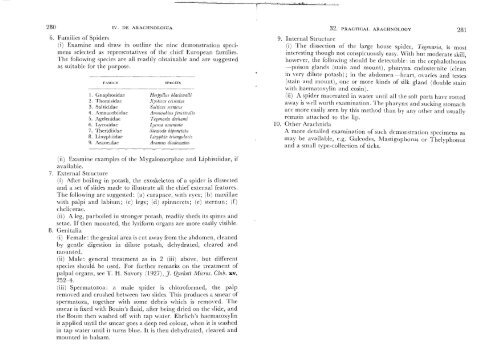You also want an ePaper? Increase the reach of your titles
YUMPU automatically turns print PDFs into web optimized ePapers that Google loves.
280 IV. DE ARACHNOLOGIA<br />
6. Families of Spiders<br />
Examine and draw in outline the nine demonstration specimens<br />
selected as representatives of the chief European families.<br />
The following species are all readily obtainable and are suggested<br />
as suitable for the purpose.<br />
FAMILY<br />
!. Gnaphosidae<br />
2. Thomisidae<br />
3. Salticidae<br />
4. Amaurobiidae<br />
5. H~Cl!;;'lllLlO.L<br />
6. Lycosidae<br />
7. Theridiidae<br />
8. Linyphiidae<br />
9. Araneidae<br />
SPECIES<br />
Hupyllus blackwalli<br />
Xysticus cristatus<br />
Sulticus scenicus<br />
Amourobius fenestrulis<br />
Tegenaria derhami<br />
Lycasa amentata<br />
Steatoda bipunctata<br />
Linyphia triangularis<br />
Araneus diadematus<br />
32. PRACTICAL ARACHNOLOGY 281<br />
9. Internal Structure<br />
(i) The dissection of the large house spieler, Tegenaria, is most<br />
interesting though not conspicuously easy. With but moderate skill,<br />
however, the following should be detectable: in the cephalothorax<br />
-poison glands (stain and mount), pharynx endosternite<br />
in very dilute potash) ; in the abdomen,·-heart, ovaries and testes<br />
(stain and mount), one or more kinds of silk gland (double stain<br />
with haematoxylin and<br />
A spider macerated in water until all the soft parts rotted<br />
away is well worth examination. The pharynx and stomach<br />
are more easily seen by this method than by any other and usually<br />
remain attached to the lip.<br />
10. Other <strong>Arachnida</strong><br />
A more detailed examination of such demonstration specimens as<br />
may be available, e.g. Galcodes, l\Iastigophorus or Thelyphonus<br />
and a small type-collection of ticks.<br />
(ii) Examine examples of the Mygalomorphae and Liphistiidae, if<br />
available.<br />
7. External Structure<br />
(i) After boiling in potash, the exoskeleton of a spider is dissected<br />
and a set of slides made to illustrate all chief external features.<br />
The following are suggested: (a) carapace, with eyes; (b) maxillae<br />
with palpi and labium; (c) legs; (d) spinnerets; (e) sternun; (f)<br />
chelicerae.<br />
A leg, parboiled iu stronger potash, readily sheds its spines and<br />
setae. If then mounted, the lyriform organs are more easily visible.<br />
8. Genitalia<br />
Female: the genital area is cut away from the abdomen, cleaned<br />
by gentle digestion in dilute potash, dehydrated, cleared and<br />
mounted.<br />
(ii) Male: general treatment as in 2 (iii) above, but different<br />
should he used. For further remarks on the treatment of<br />
palpal organs, see T. H. <strong>Savory</strong> (1927), J. Quekett M£cros. Club. xv,<br />
252~4.<br />
(iii) Spermatozoa: a male spider is chloroformed, the palp<br />
removed and crushed between two slides. This produces a smear of<br />
spermatoza, together with some debris which is removed. The<br />
smear is fixed with Bouin's fluid, being dried on the slide, and<br />
the Bouin then washed off with tap water. Ehrlich's haematoxylin<br />
is applied until the smear goes a deep red colour, when it is washed<br />
in tap water until it turns blue. It is then dehydrated, cleared and<br />
mounted in balsam.















